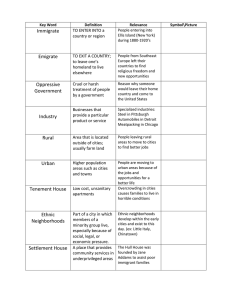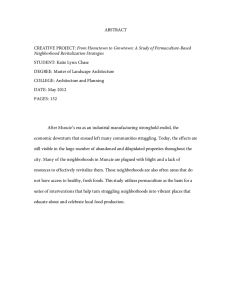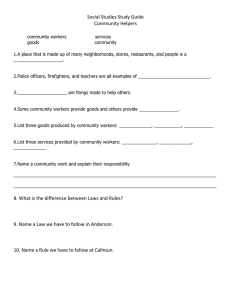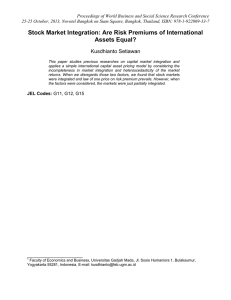LING 122: ENGLISH AS A WORLD LANGUAGE - 16 Language Contact:
advertisement
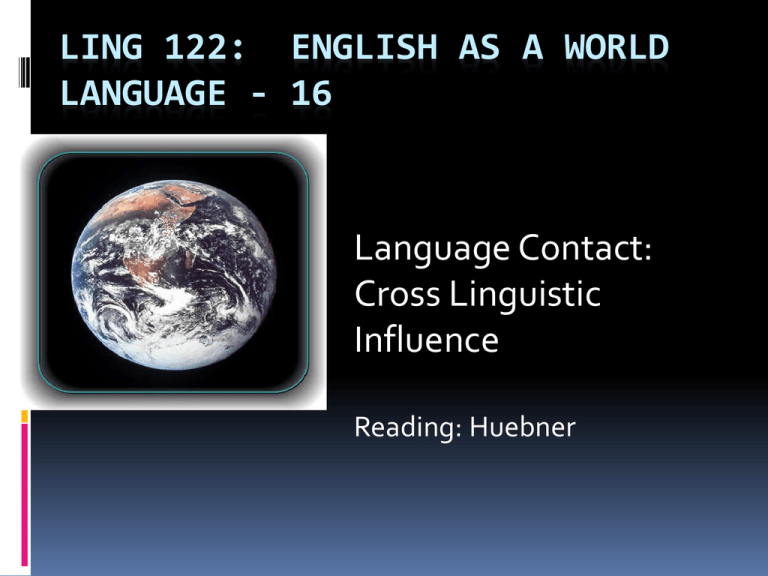
LING 122: ENGLISH AS A WORLD LANGUAGE - 16 Language Contact: Cross Linguistic Influence Reading: Huebner Language Contact: A situation of geographical continuity or close social proximity between languages or dialects, so that a degree of bilingualism comes to exist within a community. The languages then begin to influence each other, such as by introducing loan words or making changes in pronunciation. (David Crystal, 1992. An Encyclopedic Dictionary of Language and Languages, Oxford: Blackwell, p. 216.) Examples? Language Contact often results in… Borrowing (Load words) Bilingualism (Individual and/or societal) Balanced, dominant, passive, semilingual Code switching Inter- and intra-sentential Contact-influenced language change Phonological, lexical, syntactic, orthographic Mixed forms of language e.g., ‘Spanglish, Chinglish, Taglish, etc. Pidgins and creoles Caribbean, West African, Pacific, etc. Code switching – Latino (Hispanic) English There is no homogeneous Latino dialect. Puerto Rican English Cuban English Chicano English Etc. Bilingual Latinos engage in code-switching. My mom fixes tamales verdes Mi mamá hace green tamales *My mom fixes verdes tamales. Why do people engage in code-switching? What are linguistic landscapes? Landry and Bourhis (1997, cited in Shohamy et al. 2001) define “linguistic landscape” as all linguistic tokens “which mark the public sphere, including road signs, names of sites, streets, buildings, places and institutions as well as advertising billboards, commercials and even personal visit cards.” Where to witness language contact: Linguistic Landscapes What can we learn from linguistic landscapes? The overt language policies of the state. The status and power relations within a given speech community. The values, aspirations, cultural identity of that community. The social structure of the community. The effects of globalization and language contact on the languages themselves. What is a speech community? “... any human aggregate characterized by regular and frequent interaction by means of a shared body of verbal signs and set off from similar aggregates by significant differences in language usage. ... The speech varieties employed within a speech community form a system because they are related to a shared set of social norms" (Gumperz 1968) "A community sharing rules for the conduct and interpretation of speech, and rules for the interpretation of at least one linguistic variety.” (Hymes 1972) “... a group of people who do not necessarily share the same language, but share a set of norms and rules for the use of language. The boundaries between speech communities are essentially social rather than linguistic.” (Romaine 1994) What fascinated me about printed language in the public space in Bangkok – Is there any pattern to the use of language? If so, what is it? What do the residents of Bangkok perceive of and feel about the use of language in the public space? What influence if any does the use of language mixing in the public space have on the languages involved? Bangkok: Some demographic facts Bangkok, the capital of Thailand, has a population of about 9 million. Bangkok has a true international culture with a sizable population of immigrants from China, Japan, India, America, Europe, Taiwan, South Korea, Nigeria, Malaysia and Singapore. Bangkok is also believed to be a host for a good number (approx. 400 – 600 thousand) of illegal immigrants from Cambodia, Myanmar (Burma), Russia, Ukraine, Pakistan, Nigeria, India, Bangladesh, China, and other countries. Some Bangkok neighborhoods Some Bangkok neighborhoods My students and I looked at fifteen neighborhoods in central and suburban Bangkok which they felt would reflect some of the linguistic diversity of the city . Pathum Thani Thanon Phichai Koh Kret Henri Dunont Phra Athit Charoen Krung Yawarat Saphan Han Siam Square Sukhumvit Sky Train Khao San Thong Law Thaniya Soi Nana Speech Communities Results All Bangkok signs by script Government vs. non-government signs Signs by neighborhoods Pathum Thani, Thanon Phichai, Koh Kret Henri Dunont, Phra Athit Charoen Krung, Yawarat Saphan Han, Siam Square, Sukhumvit, Sky Train Khao San, Thong Law, Thaniya, Soi Nana Code switching in signs Language ideology in signs Conclusions Figure 1: Bangkok Signs by Script OTHER, 91, 15% T / C, 17, 3% T, 158, 26% T R T / R / C, 38, 6% T/R T/R/C R, 106, 17% T / R, 203, 33% T/C OTHER Figure 2: Bangkok Signs by Script and Source (Government vs. Non-government) 60 50 40 Govern. 30 Non-gov. 20 10 0 Thai Rom an T/R T / R/ C T/C Other Government vs. non-government signs Government signs reflect official government language policy. Non-government signs reflect the ideologies of the speech communities in which they appear. Language Policy in the Linguistic Landscape Signs by neighborhoods Monolingual Thai neighborhoods Pathum Thani, Thanon Phichai, Koh Kret Balanced monolingual Thai and Bilingual Thai- English neighborhoods Henri Dunont, Phra Athit Thai/Chinese Multilingual Sign Neighborhoods Charoen Krung, Yawarat Thai/English Bilingual Sign Neighborhoods Saphan Han, Siam Square, Sukhumvit, Sky Train Non-Thai Dominant Neighborhoods Khao San, Thong Law, Thaniya, Soi Nana Monolingual Thai neighborhoods Balanced monolingual Thai and Bilingual Thai-English neighborhoods Thai/Chinese Multilingual Sign Neighborhoods Thai/English Bilingual Sign Neighborhoods Non-Thai Dominant Neighborhoods Code-Switching – The standard definition The concurrent use of more than one language, or language variety, in conversation. Multilinguals—people who speak more than one language—sometimes use elements of multiple languages in conversing with each other. Thus, codeswitching is the use of more than one linguistic variety in a manner consistent with the syntax and phonology of each variety. Code-Switching in the Linguistic Landscape Reh’s (2004) taxonomy of multilingual information arrangement 1) Duplicating, - all information presented in both languages; 2) Fragmentary - all information in Language A; some in Language B 3) Overlapping - some but not all of the information contained in Language B is also contained in Language B, and vice versa; 4) Complementary - two or more languages convey completely different content. Code-Switching in the Linguistic Landscape Duplicating Fragmentary Hybridity in the Linguistic Landscape ‘Golf Center Lynx’ ‘K. L. Fashion House’ Hybridity in the Linguistic Landscape Language, Identity and the Contestation of Space Language, Identity and the Contestation of Space Language, Identity and the Contestation of Space Conclusions English in Bangkok is not always directed at foreigners. The linguistic variation across neighborhoods is more diverse than sometimes assumed. How language is used in signs doesn’t always reflect official language policy. Signs reflect the relative power and social status of various groups within a given community. Signs reflect the nature of the activities these groups are engaged in. Code switching occurs in signs and often results in hybrid varieties. Signs reflect the language ideologies of the speech communities in which they appear. Over time, variation in language use patterns across older vs. newer neighborhoods can provide hints about changing patterns of language use. THANK YOU


